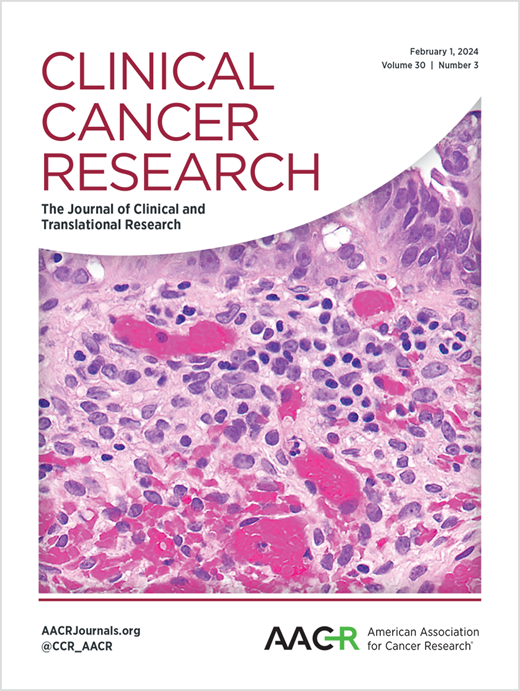一项新的免疫原性细胞死亡诱导小分子PT-112在复发或难治性多发性骨髓瘤中的I期临床研究和体内发现
IF 10.2
1区 医学
Q1 ONCOLOGY
引用次数: 0
摘要
sep -112是一种新的免疫原性细胞死亡(ICD)诱导小分子,目前在几种癌症类型的2期开发中。它抑制核糖体生物发生并引起细胞器应激,导致癌细胞选择性ICD。PT-112的焦磷酸盐部分可能驱动高药物浓度到达疾病的骨部位,这使得人们对PT-112在多发性骨髓瘤中的应用产生了兴趣。在这里,我们展示了PT-112治疗复发或难治性多发性骨髓瘤(RRMM)的I期和体内研究结果。实验设计采用激光烧蚀电感耦合等离子体质谱法分析pt -112在小鼠体内的生物分布。PT-112的活性在新生和变异型Vk*MYC多发性骨髓瘤小鼠模型中作为单一治疗或联合治疗进行评估。测量M-spike水平和存活率。PT-112单药治疗的I期剂量递增研究采用3+3设计,在已用尽可用疗法的重度预处理RRMM患者中进行。结果体内生物分布成像显示其在骨、肾、肺、皮肤和肝脏均有高浓度分布。PT-112在Vk*MYC多发性骨髓瘤小鼠模型中单独或联合均有活性。I期数据显示PT-112单药治疗是安全且耐受性良好的,建立了推荐的2期剂量360 mg/m2,在28天周期的第1、8和15天。观察到确认的反应和其他活动信号。结论这些结果提示Vk*MYC模型系统缺乏与标准护理的交叉抗性,并支持该模型系统的转化价值。PT-112在多发性骨髓瘤中的进一步临床研究是有必要的。本文章由计算机程序翻译,如有差异,请以英文原文为准。
A Phase I Clinical Study and In Vivo Findings with PT-112, a Novel Immunogenic Cell Death-Inducing Small Molecule, in Relapsed or Refractory Multiple Myeloma.
PURPOSE
PT-112 is a novel immunogenic cell death (ICD)-inducing small molecule under Phase 2 development in several cancer types. It inhibits ribosome biogenesis and causes organelle stresses, leading to selective ICD in cancer cells. The possibility of PT-112's pyrophosphate moiety driving high drug concentrations to bone sites of disease led to an interest in PT-112 use in multiple myeloma. Here, we present findings from Phase I and in vivo studies for PT-112 in relapsed or refractory multiple myeloma (RRMM).
EXPERIMENTAL DESIGN
PT-112 biodistribution was analyzed in mice via laser ablation inductively coupled plasma mass spectrometry. Activity of PT-112 was assessed in de novo and variant Vk*MYC multiple myeloma mouse models as monotherapy or combination therapies. M-spike levels and survival were measured. A Phase I dose escalation study of PT-112 monotherapy was conducted using 3+3 design in heavily pretreated RRMM patients with exhausted available therapies.
RESULTS
In vivo biodistribution imaging revealed high concentrations in bone, kidney, lung, skin, and liver. PT-112 was active in Vk*MYC multiple myeloma mouse models, alone and in combination. Phase I data showed that PT-112 monotherapy was safe and well-tolerated, establishing a recommended Phase 2 dose of 360 mg/m2 on days 1, 8, and 15 of a 28-day cycle. Confirmed responses and other signals of activity were observed.
CONCLUSIONS
These results suggest a lack of cross-resistance with standard of care and support the translational value of the Vk*MYC model system. Further clinical investigation of PT-112 is warranted in multiple myeloma.
求助全文
通过发布文献求助,成功后即可免费获取论文全文。
去求助
来源期刊

Clinical Cancer Research
医学-肿瘤学
CiteScore
20.10
自引率
1.70%
发文量
1207
审稿时长
2.1 months
期刊介绍:
Clinical Cancer Research is a journal focusing on groundbreaking research in cancer, specifically in the areas where the laboratory and the clinic intersect. Our primary interest lies in clinical trials that investigate novel treatments, accompanied by research on pharmacology, molecular alterations, and biomarkers that can predict response or resistance to these treatments. Furthermore, we prioritize laboratory and animal studies that explore new drugs and targeted agents with the potential to advance to clinical trials. We also encourage research on targetable mechanisms of cancer development, progression, and metastasis.
 求助内容:
求助内容: 应助结果提醒方式:
应助结果提醒方式:


